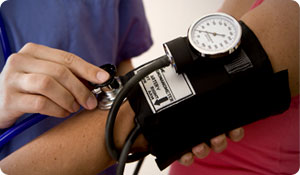
See what people are saying about this article on our Facebook page!![]()
If you're a middle-aged woman with high blood pressure, you're at an increased risk of heart attack. What can you do to lower your blood pressure (and your risk)?
Why Middle-Aged Women Are at Risk
"Having high blood pressure is not a good thing, especially for this age group," says Furqan H. Tejani, MD, FACC, director of advanced cardiovascular imaging at the Long Island College Hospital in New York City.
While traditionally women are "10 years behind men in heart attack risk," Tejani explains, "If you are a middle-aged woman with high blood pressure, your chances of having heart disease are higher than a man's. The women who are most at risk are those who are in perimenopause or just entering menopause."
High blood pressure can be a "silent killer," says LeRoy Rabbani, an interventional cardiologist at NewYork-Presbyterian Hospital/Columbia Medical Center in New York City. "And many women don't even realize they have it."
9 Ways to Lower Your Blood Pressure
To preserve heart health and reduce your risk of a possible heart attack, try the following:
- Get your blood pressure checked on a regular basis. Once a year is a good place to start, unless your doctor tells you otherwise. Even a slightly abnormal blood pressure reading should trigger a visit to your health care provider, Tejani says.
- Don't rely on a home blood pressure monitor. "These are notorious for incorrect readings," Tejani says.
- Lower your sodium intake. It can be hard if you love salt, but once you learn to substitute herbs and spices for table salt, it gets a lot easier. There's also a low-sodium salt that's widely available; it gives a very similar flavor to food.
- Know your limits. Not sure how much salt you can have? "For an individual with high blood pressure, sodium intake really should not exceed two grams [2,000 mg.] a day," Tejani says. Some experts recommend no more than 1,500 mg. a day.
- Get regular exercise. Start out slow, with walking. Later when you're getting back in shape, get in the habit of jogging, fast walking, or aerobic dancing.
- Recognize that you may be under more stress than your partner. "A woman forms the nucleus of the household," Tejani says. "She may be a breadwinner, but she is also the money manager and the manager of organization for the whole house. A woman has to take care of everyone else before she can take care of herself."
- Learn some stress reduction techniques. Stress can aggravate a blood pressure problem, so take a yoga class, or learn to meditate and do it on a daily basis. Find whatever calms you down, and practice it regularly.
- Keep your doctor informed. If you make healthy changes, but your blood pressure is still not in the normal range, be sure your doctor is aware of the situation; he or she can help. For instance, "Medications are an effective strategy to control blood pressure," Tejani says.
- Take your blood pressure reading seriously. "Monitoring your blood pressure unquestionably reduces your heart attack risk," Tejani says. "And especially in women, it improves cardiovascular [heart and blood vessel] health."
- If you drink, keep your intake moderate. "Too much alcohol can raise the blood pressure," Tejani says.
See what people are saying about this article on our Facebook page!![]()





